|
|
 |
| My Favourite Planet > Blogs > Cheshire Cat Blog > 2010 |
 |
 |
back |
The Cheshire Cat Blog
 |
| |
16 September 2010 |
 |
| |
 |
 |
Istanbul essentials - Part 1
Istanbul's other inhabitants |
| |
Istanbul is one of the world's greatest cities, economically, culturally, historically,
as well as in terms of size and population. With possibly more monuments per
square kilometre than any other city on the planet, it's no wonder that it is one
of UNESCO's most important world heritage locations and has finally been
selected as European Capital of Culture 2010.
Like every great city, it has its distinct districts, nooks, crannies
and idiosyncrasies. As a foretaste of the My Favourite Planet
guide to Istanbul David John shows us a few of them.
In Part 1 he takes a look at some of Istanbul's non-human denizens.
For Ilker and Lucy.
See also: Istanbul essentials Part 2 and Istanbul essentials Part 3 (with video). |
 |
|
| |
| Istanbul Ducks |
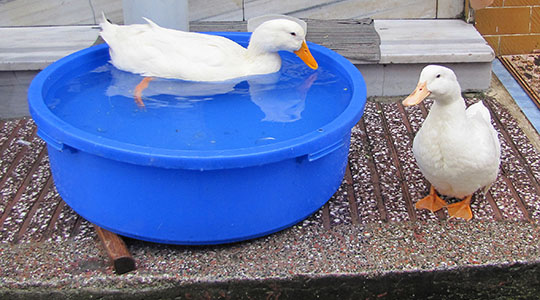
Space is at a premium in Istanbul, and your hotel swimming pool
may not be up to Olympic dimensions. Please have patience
and wait for your fellow guests to finish bathing.
Cankurtaran, Istanbul |
| |
| Stamboul sheep |
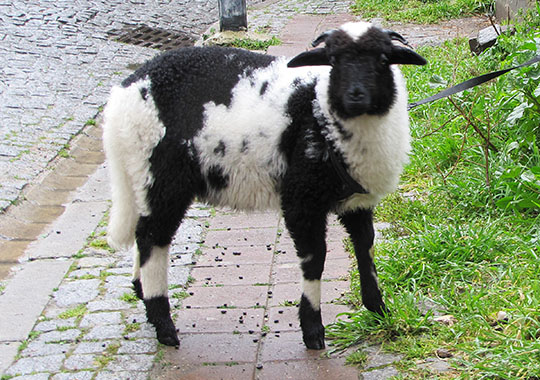
We would advise that you keep your sheep on a tight lead
in order to avoid scaring the local packs of wild dogs. Also
keep an eye on your neighbourhood herb garden.
Cankurtaran, Istanbul |
| |

Some people, of course, prefer to keep plastic sheep:
they are not so cuddly, but you don't have to feed them
and they won't keep you awake all night with their bleating.
Fatih, Istanbul |
| |
| |
Ain't nobody here but us chickens |
 |
|
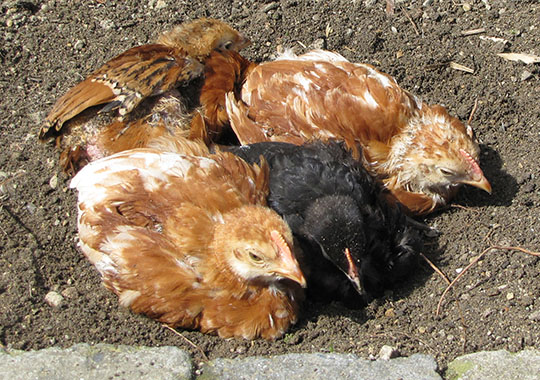
Chickens huddle together for warmth against the early morning chill,
and wonder which came first, the human or the automobile?
Sultanahmet, Istanbul |
| |
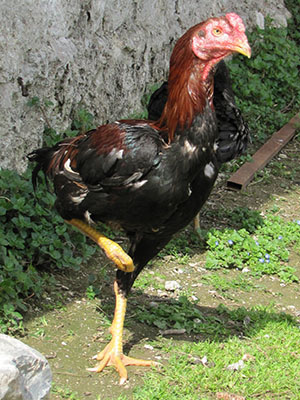
Meanwhile, pappa struts around a bit and tries to look tough.
Sultanahmet, Istanbul |
| |
| |
Ants in my pants |
 |
|
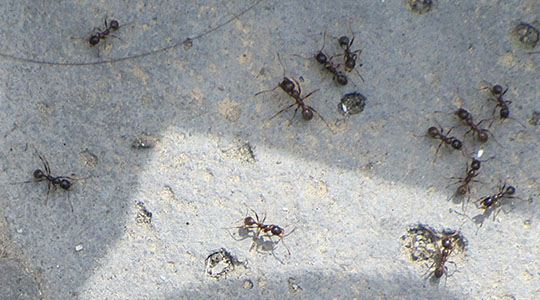
I love work; I could watch it for hours. And these guys never disappoint.
They seem to be continuously scurrying around and picking up the
stuff tourists drop. Masters of recycling.
"Ask the snail beneath the stone,
Ask the stone beneath the wall
Are there any stars at all?"
The Incredible String Band
Waltz of the new moon by Robin Willamson
from the album The Hangman's Beautiful Daughter
Nothing whatsoever to do with ants, I just like the song.
Near the Blue Mosque, Sultanahmet, Istanbul |
| |
| |
The Cheshire Cat visits
his Istanbul cousins |
 |
|
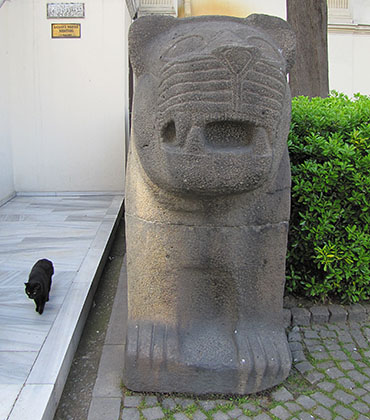
Some cats' mothers are bigger than other mother cats.
The larger of the felines is one of a pair of 8th century BC late Hittite stone
portal lions made of basalt, from Samal (Zincirli) in southeastern Turkey.
The smaller disdained to be interviewed and wishes to remain anonymous.
Outside the Museum of the Ancient Orient, Topkapi Palace complex, Istanbul |
| |
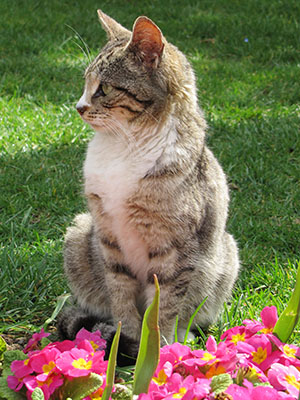
Some cats are far too cute.
Gardens of the Topkapi Palace, Istanbul |
| |
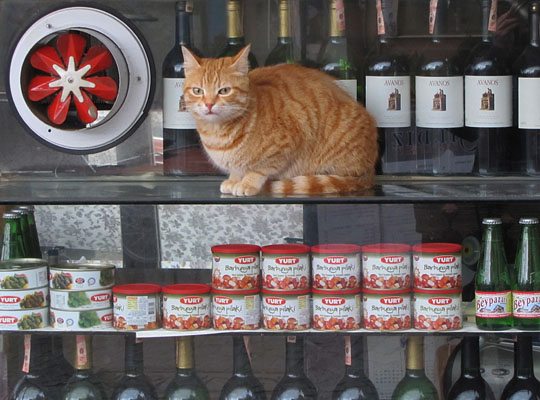
Some cats like grocery stores.
Cankurtaran, Istanbul |
| |
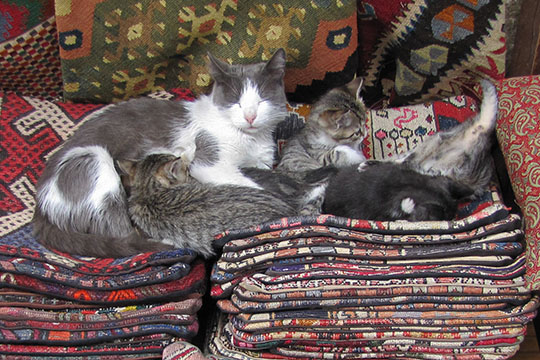
The family test the comfort factor of traditional Turkish carpets.
Arasta Bazaar, Sultanahmet, Istanbul |
| |
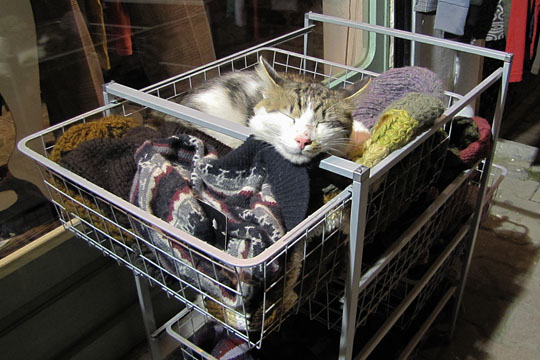
Other cats prefer modern knitwear.
Galata, Istanbul
See below for information about Dr. Henrik Hofmann's blog
Istanbul is the land of cats. |
| |
| |
What's the difference between
a dove and a pigeon? |
 |
|
 Doves on the look-out for their next meal. Doves on the look-out for their next meal.
Outside the Blue Mosque, Sultanahmet, Istanbul
|
| |
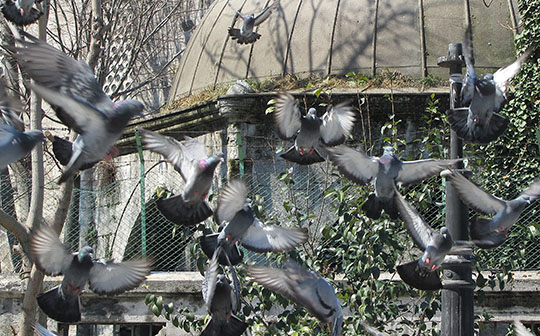
Pigeons in a flurry.
Atik Ali Pasha Mosque, near the Grand Bazaar, Istanbul |
| |
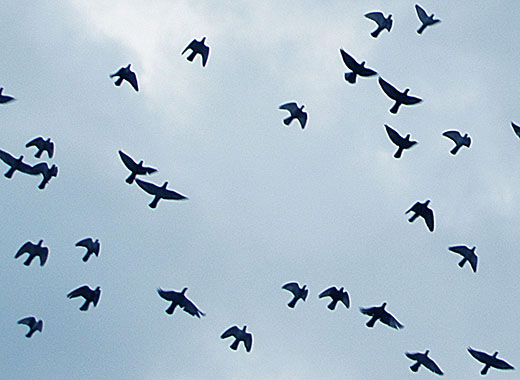
Pigeons off to their next photo opportunity.
But where do they all come from? See photo below
Near the Blue Mosque, Sultanahmet, Istanbul |
| |
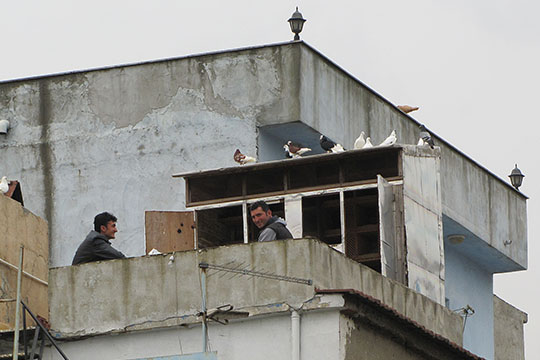
Many of Istanbul's pigeons and doves live in pigeon hostels such as this one.
Pigeon fanciers drinking tea at their luxury pigeon penthouse.
Near the Kuçuk Aya Sofia Mosque, Istanbul |
| |
| |
In search of fish |
 |
|
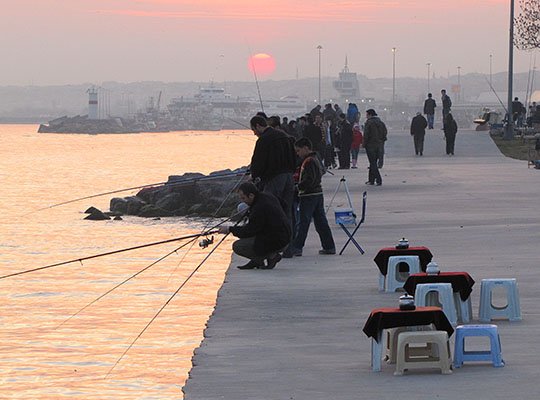
So, where are all the fish?
Sunset anglers on the shore of the Sea of Marmara.
Angling is a massively popular hobby and a source of food and income for
Istanbulers. You will find anglers just about anywhere men (and a few
women) can stand and throw a line into the water, especially on Sundays. In the evenings small groups of men will put up a makeshift shelter
or windbreak on the shore and grill their catch on the spot.
Near the Yeni Kapi ferry harbour (in the background), Istanbul |
| |
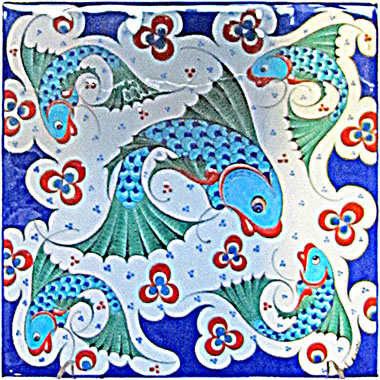
Well, I didn't manage to see any living fish during my last
visit to Istanbul, apart from tropical types in glass tanks
and several dead ones in fishmongers and restaurants.
Many people claim to see dolphins regularly quite near the
Marmara Sea coast to the south of Sultananhmet. Once again
I failed miserably to spot any aquatic mammals whatsoever.
By way of consolation, here is a photo of a colourful
ceramic tile depicting fish in a traditional Turkish style.
Souvenir shop, Arasta Bazaar, Sultanahmet, Istanbul |
| |
| |
Tulips to Amsterdam |
 |
|
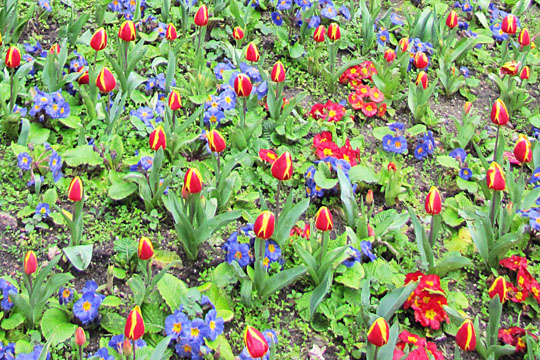
Tulip madness
|
The tulip has become one of the symbols of Istanbul, and the flowers can be found all over the city in various glorious forms and colour combinations.
Like the Turkish people themselves, the tulip originated in Central Asia and was brought to Europe from Istanbul during the mid 16th century by travellers, ambassadors and merchants.
In the Netherlands during the 1630s tulip bulbs were traded at astronomical prices until the bubble suddenly burst in February 1637 and ended "tulip mania".
Istanbul also had its own tulip craze during the so-called Tulip Period (Lâle Devri) of the Ottoman Empire 1718-1730. A relatively peaceful and prosperous time in which the arts and architecture flourished and people were mad for anything to do with tulips. As in Holland, the price of tulips rocketed, the economic consequences of which led to the anti-tulip rebellion in 1730.
Outside the Arasta Bazaar, Sultanahmet, Istanbul |
|
| |

Magpie on the minaret of the Ishak Pasha Mosque |
| |
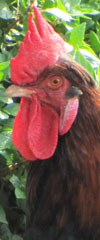
egg production executive |
| |
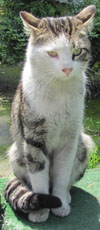
another Istanbul cat |
| |
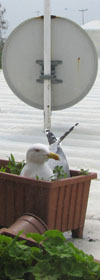
nesting seagull |
| |

Blue Mosque
minaret, Istanbul |
| |
| |
| |
Gulls and buoys |
 |
|

Seagulls on sentry duty.
A lot of people don't like seagulls: they see them as vicious, agressive, shameless
opportunists who shit on everythig. A bit like many humans, really. But they are quite
beautiful animals and superb aviators. What would the seaside be without them?
Near the Blue Mosque, Sultanahmet, Istanbul |
| |
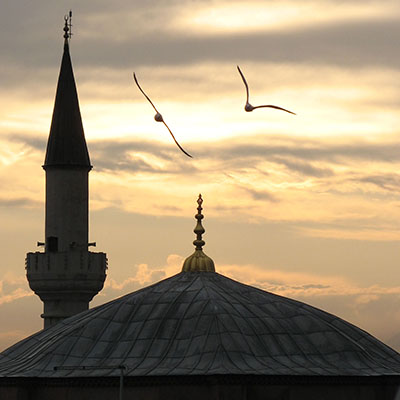
Seagulls fly over the dome of the Kuçuk Aya Sofia Mosque.
Çatladikapi, Istanbul photo: © Konstanze Gundudis |
| |
| |
Hi ho, Silver! |
 |
|
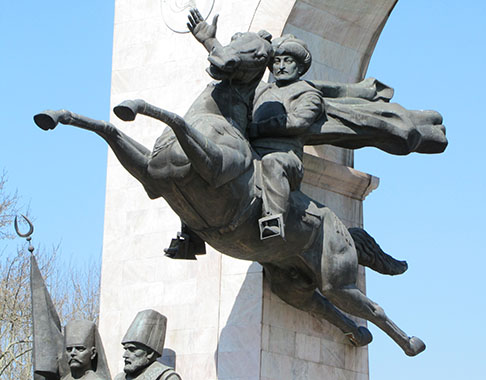
You'll believe a horse can fly!
The Fatih Sultan Mehmet Anıtı (monument) in Saraçhane Park, Aksaray
|
This is the only remaining public sculpture in Istanbul I can think of which can be described as equestrian. It is part of a sculptural group in Sarachane Park near the 4th century Aqueduct of Valens depicting solemn-looking types in beards. There is no inscription to enlighten us as to who made these sculptures or what events they represent. One can only assume that the subject matter is so familiar to local people that it needs no explanation.
The flying rider is in fact Sultan Mehmed II, known in Turkish as Fatih Sultan Mehmet - the Conquerer - after whom Istanbul's Fatih area and disrict are named. Presumably the other figures are his generals, advisors and/or kinsmen. Mehmet conquered Constantinople on 29 May 1453, one of his many conquests which consolidated and expanded the Ottoman Empire and finally put an end to the last remnants of the 1000 year-old Byzantine Empire.
Not only did I not spot any live dolphins or fish around Istanbul, I also noticed the total absence of horses on the city streets. It has been a while since my last visit here, but I remember there used to be horses pulling all manner of vehicles and wares around town. Where have they all gone? Have they been banished from the centre, or have they simply been replaced by the ubiquitous Japanese mini-vans? The hectic pace of noisy traffic here and the arrival of new tramlines make the Istanbul street an unhappy place for horses anyhow.
If you are a horse fan and fancy being chauffered around in an open carriage, try the nearby Princes' Islands, where motor vehicles are banned and the horse still rules. |
|
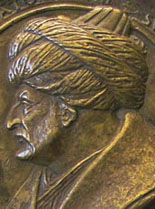
Sultan Mehmed Fatih
Detail of a bronze
medallion by Constanzo
de Ferrara, 1481.
Bodenmuseum, Berlin. |
|
| |
| |
Bearing up |
 |
|
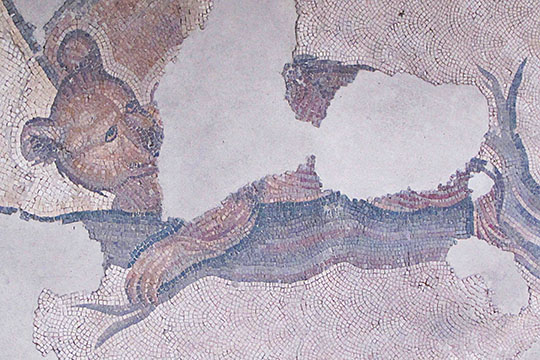
Bear up a tree
|
Right here there should be photo of a real bear. But as with the fish and the horses (see above), I didn't manage to get an Istanbul bear in front of my camera lens.
Until a decade or so ago it was not uncommon to see dancing bears throughout the Balkans and Turkey. Pulled along by a chain fastened to a ring through the nose, the creatures were led to towns and villages and made to perform during local festivities.
On a previous visit to Istanbul I visited the local zoo, where adults encouraged children to taunt and throw objects at distressed-looking bears in a tiny squalid cage. Perhaps things have improved for the animals since, but I couldn't face the prospect of their misery again. *
Bears fared much worse during Roman times, and many of the mosaics in the Great Palace Mosaic Museum show animals being hunted and tortured for sport as well as gladiatorial duels. Strange people, those Romans.
Great Palace Mosaic Museum, Sultanahmet, Istanbul
Bogazici Zoo and Botanic Park
* Since writing this blog I visited Gülhane Park in the Sultanahmet district again, and indeed the terrible old zoo has been closed down. The new, Bogazici Zoo and Botanic Park, Turkey's first privately run zoo, is on the Asian side of the Bosphorus, about one hour from the centre of Istanbul, at the seaside town of Darıca, in the Kocaeli Province of the Marmara region.
At the time of writing this, I could find no website for the zoo and there appears to be very little information available about it. It seems that it has a large collection of exotic birds and is planning to open a large aquarium. |
|
|
| |
| |
| |
Istanbul, the land of cats
Since writing this blog I have visited Istanbul again (see Istanbul essentials - Part 3: Istanbul wedding dance).
There I had the pleasure of meeting Dr. Henrik Hofmann, a vet from Butzbach in Germany, who was visiting the city with his family. Henrik is a man with ideals and an active interest in animal welfare. He runs a blog in German called Es Spricht (It speaks) about his works and interests. The 30 April 2011 edition, "Istanbul ist Katzenland" (Istanbul is the land of cats) www.es-spricht.de/katzen-in-istanbul/, features several of his wonderful photos of cats in Istanbul to accompany his article about the plight of the enormous number of stray animals in the city.
In the blog he also calls for information about animal protection organizations in Turkey.
If you can help him, please send a message through his blogsite.
David John, May 2011. |
|
| |
|
| |
| |
Istanbul: Some background information |
 |
|
| Byzantium, Constantinople, Istanbul |
The area of Istanbul was inhabited as far back as 9,000 years ago during the Neolithic era. Between the 13th and 11th centuries BC Thracian tribes established two settlements, Lygos and Semistra, near the site of the present Topkapi Palace. The Thracians were driven out around 660 BC by Greeks from Megara under King Byzas who founded Byzantium (Greek Byzantion). The city was strategically important in controlling the Bosphorus as a route between the Mediterranean and Black Seas and a crossing point between Europe and Asia.
In 73 AD Byzantium became part of the Roman Empire, and when Constantine I became emperor in 324 AD he replanned it as the new eastern imperial capital Nea Roma (New Rome). However it quickly became known as Constantinople (Konstantinoupolis, the city of Constantine), a name which stuck right into the 20th century. In 330 AD the city was proclaimed capital of what was to become known as the Eastern Roman Empire or Byzantine Empire. It also became the powerful centre of the Greek Orthodox church and medieval Greek culture.
Byzantine power began to decline by the beginning of the 13th century, and in 1204 Constantinople was captured by Roman Catholic troops of the Fourth Crusade, after which it became part of the Latin Empire. The enfeebled Byzantine Empire managed to reestablish itself in 1261 but the Ottoman Turks were soon to set themselves the task of conquering it.
Sultan Mehmed II "the Conqueror" took Constantinople on 29 May 1453, and thereafter it became a predominantly Muslim city.
The name Istanbul (or Stamboul) had been used for centuries, but only became the official name in 1930 following the establishment of the Turkish Republic by Atatürk and his Young Turk revolution. "Istanbul" derives from the Greek στην Πόλη (stin poli: in or to the City). |
|
| |
| Sultanahmet |
The name Sultanahmet is often used to describe the entire old city of Istanbul within the city walls and the peninsula on which stands. But strictly speaking, Sultanahmet is the area around the Sultanahmet Camii, also known as the Blue Mosque, which was built for Sultan Ahmet (ruled 1603-1617) by architect Mehmed Aga "Sedefkar" (died 1622) who had been an apprentice of Sinan.
Before the establishement of the modern Greater Istanbul Metropoltan Area, with its 39 districts encompassing the 5,343 square kilometres of land on the European and Asian sides of the Bosphorus Strait, the successive names Byzantium, Constantinople and Istanbul referred to the city on the peninsula itself. This also became known as Eminönü, which now just refers to the tip of the peninsula around the the Yeni Camii (New Mosque) near the Galata Bridge. Officially, the old city is now the metropolitan district of Fatih (confusingly also the name of a neighbourhood in the west of the old city, famous for its nationalistic Muslim conservatism).
The other three important modern administrative districts of the Istanbul, as far as most visitors are concerned, are Beyoğlu on the other side of the Golden Horn, which includes the areas of Galata and Taksim; and on the Asian side of the Bosphorus Strait Üsküdar (the ancient Greek Chrysopolis and medieval Scutari) and Kadıköy (the ancient Chalcedon).
As well as the names of Istanbul's official districts, locals also refer to places and neighbourhoods in terms of their proximity to local landmarks such as mosques (e.g. Sülemaniye), squares (e.g. Beyazit) and ancient city gates (kapi, e.g. Topkapi, Yenikapi). In addition, train, metro and tram stations provide orientation points around the city (or confuse you even further). |
|
|
| |

Ottoman ceramic tile inscription in the Topkapi Palace, Istanbul |
Photos and text: © David John 2010
Additional photos by © Konstanze Gundudis 2010
The Cheshire Cat Blog at My Favourite Planet Blogs
We welcome comments and feedback on these articles
and all other blogs on My Favourite Planet.
Please get in contact.
The photos on this page are copyright protected.
Please do not use them without permission.
If you wish to use any of the photos for your website,
blog, project or publication, please get in contact.
Higher resolution versions are available on request. |
 |
|
 |
Visit the My Favourite Planet Group on Facebook.
Join the group, write a message or comment,
post photos and videos, start a discussion... |
|
Views of blog authors do not necessarily reflect those of the publishers
or anyone else at, on or in the vicinity of My Favourite Planet. |
 |
| |
|
|
|